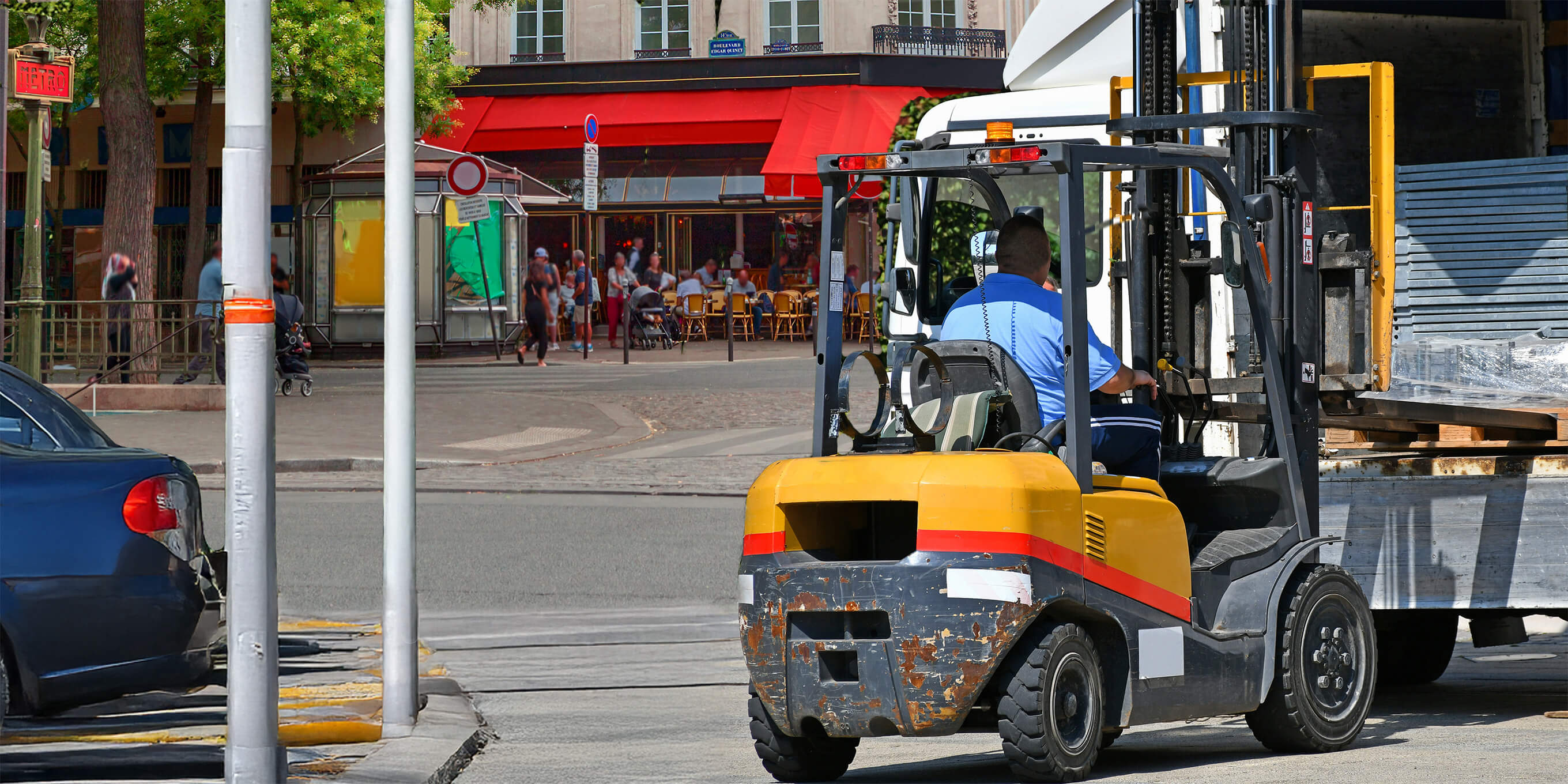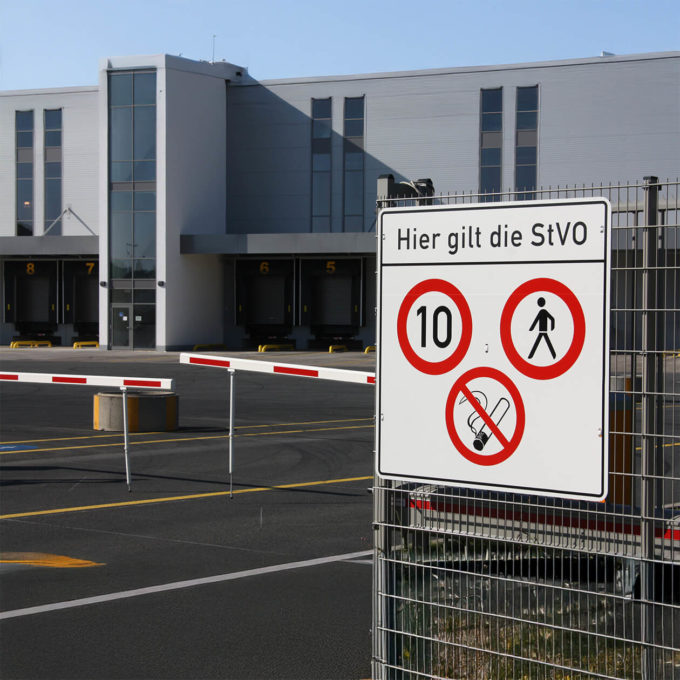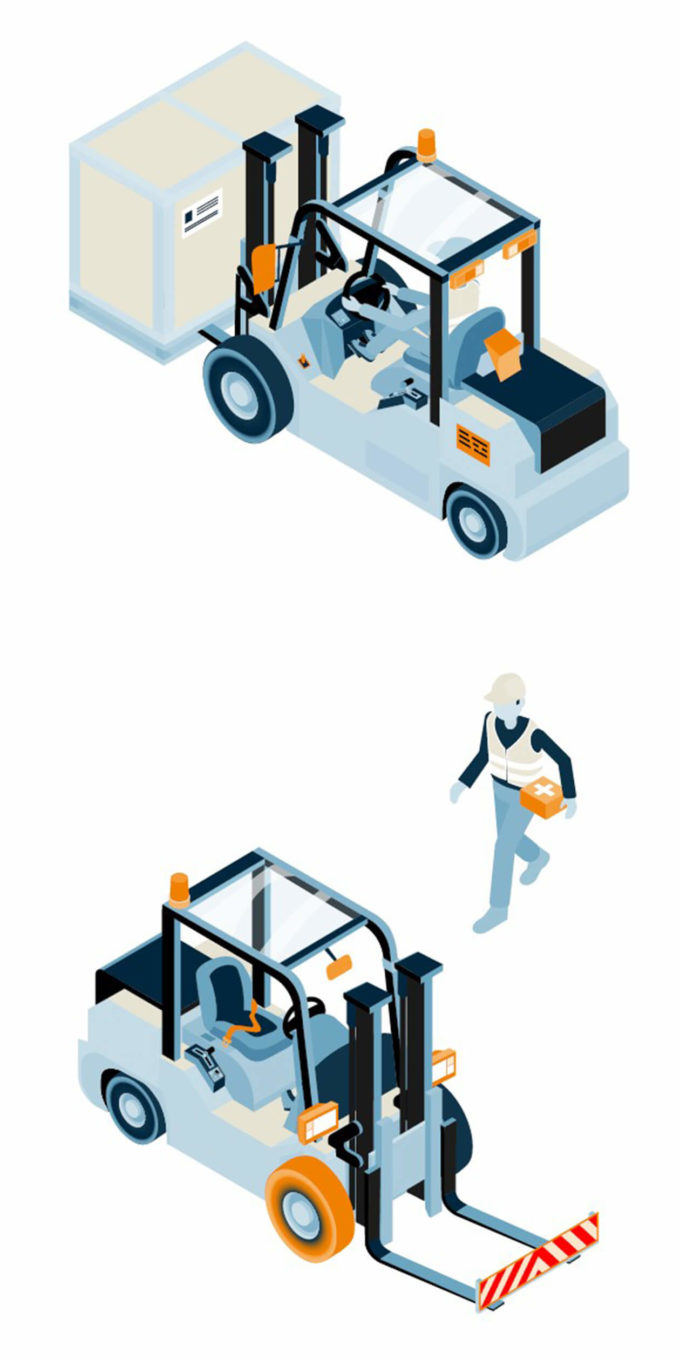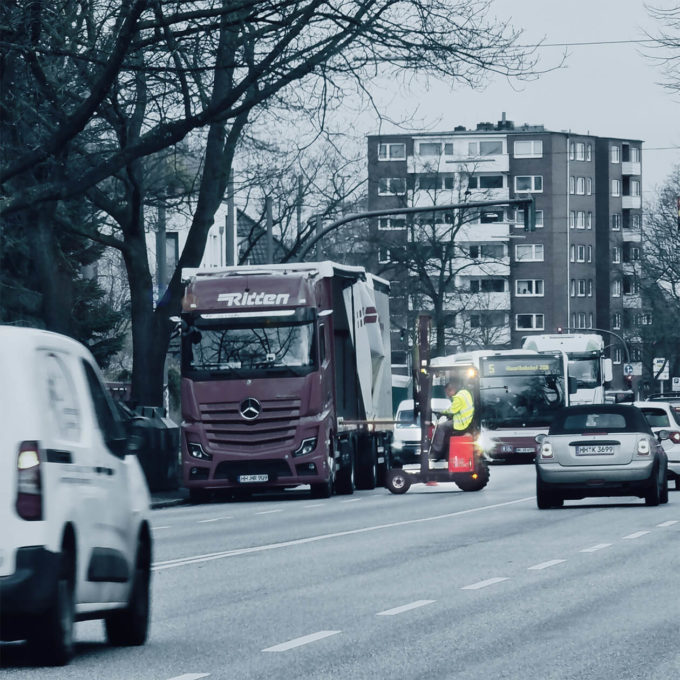
Forklift trucks on public roads: regulations, technology and driver qualifications
published on 11. February 2025
Forklift trucks on public roads? Yes, it happens – and more often than you might think! Whether crossing a road between two company premises or loading and unloading a lorry in a car park, as shown in the picture in the article, clear rules apply when forklift trucks enter public traffic areas.
The forklift truck in the picture is doing it wrong. To ensure safe and, above all, legal use, the forklift truck must be technically equipped and the driver must be appropriately qualified. Find out what’s important here!
What is considered to be part of public traffic areas?
Public traffic areas include much more than just traditional roads. All areas that can be accessed by an unspecified number of people are included, regardless of whether they are privately or publicly owned. Examples:
- car parks at DIY stores or supermarkets, if they are not cordoned off by barriers or access controls.
- company premises without a closed access road, if suppliers or visitors can enter the area freely.
- access roads to construction sites or exhibition grounds that are open to the general public during events.
As soon as a forklift truck is used in such areas, not only the internally applicable accident prevention regulation for industrial trucks (DGUV Regulation 68) applies, but the entire set of rules of road traffic law must also be observed. And that consists of the individual parts of the road traffic regulations (StVG), the Vehicle Registration Ordinance (FZV) and the Driving Licence Ordinance (FeV).


Technical equipment: What does a forklift truck need to be on the road?
Don’t worry, the above-mentioned rules, regulations and laws may be extensive, but with just a few measures, you can be on the road with legal compliance. For a forklift truck to be operated on public roads, it must have the following equipment:
Labelling
- Maximum speed of up to 6 km/h: No holder or vehicle identification is required.
- Maximum speed of 6 to 20 km/h: Holder identification is sufficient (usually regulated by public liability insurance). A sign or easily legible sticker stating the holder is sufficient.
- Over 20 km/h maximum speed: A registration number and a valid operating licence are mandatory.
Lighting
The lighting must fully comply with the provisions of the German Road Traffic Act (StVZO). This means:
- Headlights: White low beam for sufficient visibility in the dark, with parking lights.
- Rear lights: stop and tail
- Backup lights
- Turn signal: Amber flashing lights at the front and rear.
- Licence plate illumination (when travelling at over 20 km/h): for official licence plates.
The various functions, such as low beam and indicators can also be combined in combination lights.
Brakes
At least two independent braking systems: a service brake and a parking brake.
Tyres
The tyres must be suitable for use on public roads and provide sufficient grip and stability.
Mirrors and visibility
External mirrors or camera systems that provide the driver with a comprehensive field of vision.
Other
- Driver restraint system (crash bar, belt)
- Wheel chock (from 4 t total weight)
- Fork-type protective beams
- exterior mirrors
- first-aid kit
- horn
- operating licence/vehicle registration document
Requirements for the driver
Not only the forklift itself, but also the driver must be prepared so that the forklift truck may be driven on public roads:
- Forklift licence: usually required for in-house use.
- Driving licence class: Depending on the maximum speed:
- Up to 6 km/h: No driving licence required.
- 6 to 20 km/h: Class L (‘tractor driving licence’).
- Over 20 km/h: Class B (‘car driving licence’) or higher.
- Minimum age: 18.
- Regular training: The driver must be confident operating the forklift, particularly in traffic.
A forklift truck as an exceptional vehicle
Forklift trucks are generally considered to be exceptional vehicles and may use a rotating beacon under certain conditions. However, at least one of the following conditions must be met:
- The forklift is used to build, maintain or clean roads or road facilities.
- It transports exceptionally wide or long loads that require special securing.
- It moves as an exceptionally slow vehicle with considerable hazard potential.
Use as a special-purpose vehicle is regulated in § 52, paragraph 4 of the German Road Traffic Act (StVZO). If it is to be used as a special-purpose vehicle, the forklift truck also requires:
- rotating beacon: amber rotating
- red/white hazard markings in accordance with DIN 30 710

Forklifts on public roads are feasible – our conclusion
Forklifts on public roads are not as rare as you might think. Even company premises can be considered public roads, even if this is not immediately apparent. In addition to a driver qualification and compulsory insurance, legally compliant technical equipment of the forklift truck may be required. However, this is not rocket science and can usually be achieved quickly. All that remains is to create awareness of this situation.
We will be happy to help you with the lighting equipment for your forklift truck. For everything else, we can at least advise you.
Note
We have researched all of the above points to the best of our knowledge and belief, but accept no liability for any errors. Please also note that the regulations mentioned in this article describe the situation in Germany only. If a forklift truck is to be used abroad, it is advisable to find out about the relevant requirements in good time, as the regulations are not uniform even within the EU. Here are a few examples:
- In France, forklifts used on public roads must have side marker lights to increase visibility at night or in poor weather conditions. This goes beyond the standard lighting required in Germany.
- While a single exterior mirror may be sufficient in Germany, two rear-view mirrors are required in Austria to improve visibility. In addition, vehicles traveling at speeds of over 10 km/h require a license in Austria, unless they are covered by an exemption.
- In Italy, forklifts are subject to a general licensing requirement, regardless of their speed. In addition, all forklift drivers are required by law to undergo training, even if the vehicle is only used within the company.
Anyone using a forklift truck on public roads abroad should therefore find out exactly what the regulations are. The technical requirements and driving license requirements vary considerably in some cases!
tagged with Forklift trucks, Industrial trucks, Regulations, Safety



